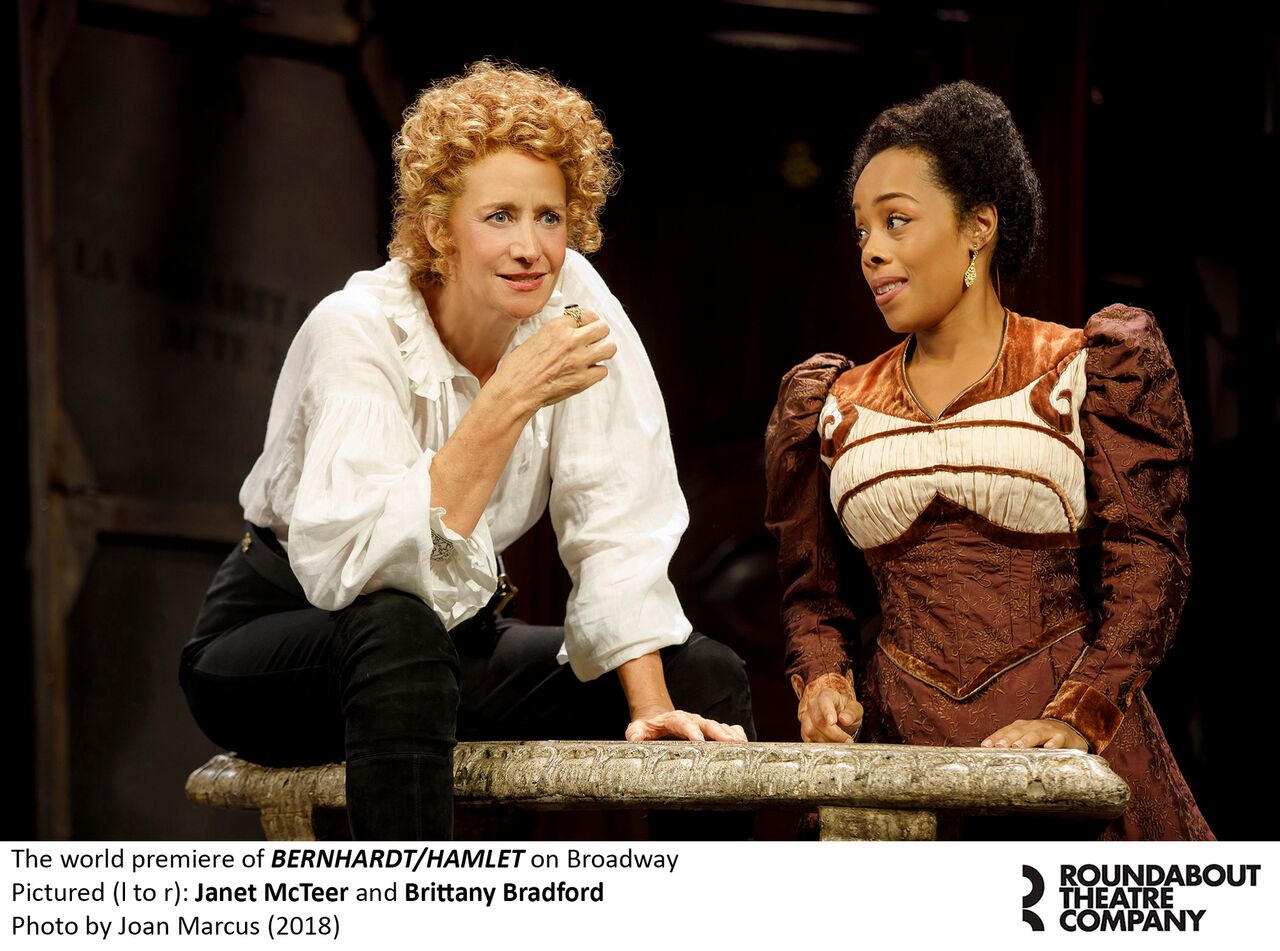
by Aileen Jacobson
The Chutzpah of Sarah Bernhardt
 Sarah Bernhardt had chutzpah. This illegitimate daughter of a Dutch Jewish courtesan had already gained wide renown as the best actress of her day when she decided to take on an exceptionally high-profile, high-risk role: She wanted to play Hamlet. Not girlfriend Ophelia or mother Gertrude, but the Danish prince himself, considered by many to be Shakespeare’s most difficult and iconic character.
Sarah Bernhardt had chutzpah. This illegitimate daughter of a Dutch Jewish courtesan had already gained wide renown as the best actress of her day when she decided to take on an exceptionally high-profile, high-risk role: She wanted to play Hamlet. Not girlfriend Ophelia or mother Gertrude, but the Danish prince himself, considered by many to be Shakespeare’s most difficult and iconic character.
It was a glass-ceiling-breaking move, one among several in Bernhardt’s career, and it inspired playwright Theresa Rebeck to build a play, set in 1897, around Bernhardt’s struggles. First Bernhardt had to overcome the dismissive skepticism of some men: “It’s grotesque. If Shakespeare meant for Hamlet to be a woman, he would have named the play ‘Hamlet princess of Denmark,” Rebeck has one critic protest.
But countering those kinds of arguments was easy for the Divine Sarah, according to Rebeck’s snappy and finely-observed play, which is currently having its world premiere in a Roundabout Theater production on Broadway. “Why shouldn’t I play Hamlet. I am perfectly suited. Nobody cares about his masculinity. So called. They care about the magnificent nuance of his heart,” says the play’s Sarah, mirroring the real Sarah’s boldly modern notions. The ideas are amplified by the strong presence of Tony-winner Janet McTeer in the starring role. She is as tall, lithe, golden voiced and assertive as the real Sarah is said to have been.
Bernhardt ran her own theater in Paris–another ceiling-breaker–so she possessed more power than many men. Her knottier problem was how to portray a moody, often passive man–he’s not called the melancholy Dane for nothing–when she herself was a decisive and passionate person. Like other actresses, she had played minor “trousers” roles before, but Hamlet was in a different class. (Times have changed: Two years ago, McTeer played Petruchio in “The Taming of the Shrew” at Shakespeare in the Park, and Glenda Jackson is scheduled to take on the role of King Lear on Broadway next year.)
Rebeck, a prolific writer for theater and television, spent about 10 years researching the play, and she explores the intricacies of gender roles, power politics and love with subtlety and wit. Her perspective–and Bernhardt’s–on these issues is complex and fresh.
At one point, Bernhardt complains that she is tired of dying every night, as many of her female roles require. Alphonse Mucha, an artist who paints her theater’s posters, points out that Hamlet dies, too. “But he kills as well.” Women “never get to kill anyone.” What about Medea, Mucha asks. “She didn’t want to kill her own children. She was furious with Jason. Women. All we ever get to do is sit around and mope for love. The power that eludes us.”
Mucha asks if power eludes her, and she replies, “Well not me, maybe that’s why Hamlet is driving me mad. All that privilege and he can’t figure out how to do anything? A woman would never have got away with it.” She sums it up: “A woman who cannot do anything is nothing. A man who does nothing is Hamlet.” She grapples with Hamlet’s passivity, eager to present Hamlet in a lively way, both for artistic reasons and to attract more theatergoers.
Unafraid to criticize Shakespeare, she complains that he used too many words, and cuts many of them (not unusual today, since the full play can take four hours). She even orders (asking is not her way) her lover, the playwright Edmond Rostand, to rewrite Shakespeare by taking out the poetry. He thinks it’s a terrible idea but agrees to do it. In the end, two other writers concocted the more direct prose version she demanded.
The play makes only one reference to her Jewish background, when Mucha tells Rostand that in the poster he painted for “La Samaritaine,” Bernhardt “is so graceful, at peace. Angelic even. You allowed her to be a Jew. I think it made her happy.” (Maybe. But her character comes to support Jesus and persuades others to convert, too.)
Bernhardt’s connection to Judaism was complicated. She was baptized and considered becoming a nun in her early years. However, many people considered her Jewish, and she never denied being Jewish. The anti-Semitism of the time and place didn’t pass her by. She was pelted with rotten eggs onstage and with stones in her carriage. But she was apparently proud of being Jewish and, when she joined the controversy surrounding Alfred Dreyfus, a Jewish army officer falsely accused of betraying France, she publicly defended him, and faced down an angry mob over her stance. She had guts.
(The play also has a reference to the figure of Lilith, though not in a flattering way. Bernhardt says the women in her theater’s costume shop whisper behind her back and “shoot daggers with their eyes” because they envy her. “You’d think I was the devil incarnate. Not him. Lilith, his succubus sister.”)
Toward the end of her life, Bernhardt wrote a short book called “The Art of the Theatre,” in which she addressed her role in Hamlet again. “Generally speaking male parts are more intellectual than female parts. That is the secret of my preference. No female character has opened up a field so large for the exploration of sensations and human sorrows as that of Hamlet.” She also wrote that “it is not male parts, but male brains that I prefer.” Of course, she didn’t consider that female playwrights, nearly unheard of in her time, would one day write about women with brains.